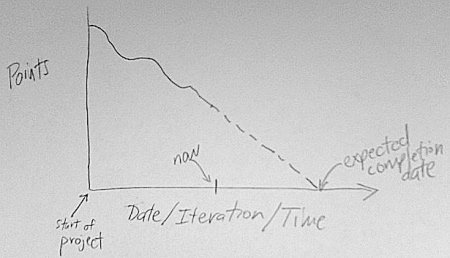For the last few months, I've been having trouble getting out of "next week" mode.
That's what I call it when I don't know what I'll be working on outside of the next week at any given time.
It's not necessarily a bad thing, but when you're working on projects that take longer than a couple of weeks,
it doesn't let you keep the end in sight. Instead, you're tunneling through the dirt and hoping you've been digging
up instead of down.

I've delivered most projects during this period
on schedule, but I did cave into pressure to
over-promise and under-deliver on one occasion. And it sucked.
When I wrote that
rewarding heroic development
promotes bad behavior, I said reducing the risk and uncertainty of project delivery
is the subject of a different story, and the discussion in the comments
got me thinking about this. There are many stories worth telling regarding this issue.
The rest of
this story is about how I'm intending to get out of my funk using
techniques that have worked for me in the past.
(Aside: As I write the words below, it occurs to me we have a chicken/egg problem of which comes first.
Just start somewhere.)
To make decent estimates there are 3 must-haves:
- Historical data as to how much you can complete in a given time frame
- Backlog of items you need to complete in the time frame you're wanting to estimate for
- The ability to break requests into sweet, chunky, chewy, bite-sized morsels of estimable goodness.

Since you haven't been doing this ["ever", "in a while"][rand*2], you don't have historical data. Your backlog
is anything on your table that hasn't been completed yet - so you've got that. Now, you need to break your
backlog apart into small enough bits to estimate accurately. This way, you practice the third item and
in a couple of weeks, you'll have historical data.
About estimating tasks:
Don't worry about estimating in units of time. You're probably not good at it. Most of us aren't, and you haven't
even given it a fair shot with some data to back up your claims. Measure in points or tomatoes.
Provide your estimate
in chocolate chips. The unit of measurement doesn't matter at this point, so pick something that
makes you happy. However, you should stay away from units of time at this point in the exercise. You're not
good at that, remember?
So I have some number of tasks that need to be completed. I write each of them down, and decide how many chocolate
chips it's going to take me to finish each one. I count in Fibonacci numbers instead of counting numbers, because
as tasks grow in time and complexity, estimates grow in uncertainty. I try to keep all of my tasks as 1, 2, or 3
chocolate chips. Sometimes I'll get up to a 5.
But if you start venturing into 8 and 13 or more, you're basically saying
IDFK anyway, so you might as well be honest and bring that out into the open. Such tasks are more like
Chewbaccas than chocolate chips, so take some time to think about
how you might break them down as far as possible.
 photo by Bonnie Burton found on starwarsblog photostream licensed CC Attribution 2.0 as of 5/21/2009
Now that you know how to estimate tasks:
photo by Bonnie Burton found on starwarsblog photostream licensed CC Attribution 2.0 as of 5/21/2009
Now that you know how to estimate tasks:
Before you start on a task -- with a preference to earlier rather than later (hopefully as soon as you know it needs to be done) --
estimate how many points it should take you, then write it down on your list of items to complete. Take note
of how many chocolate chips you finish daily. Write down the number completed and the date.
Make a graph over time comparing the number of chocolate chips you have remaining (or how many you've completed)
on the Y-axis and the date that applied to. If you use points remaining, it's a Burn Down chart. If you
go the otherway, it's not surprisingly called a Burn Up chart.

Keep a log of the number of chips you complete per week. The last two or three weeks' averages are a good indication
of how many you'll be able to do for the next few weeks, and helps planning for
individuals spanning several projects, or teams on a single project.
You can now reference your chips per week to extrapolate how long it's likely to take you to finish a particular
task or small project.
Further, you'll always want to know how many points you've got in your backlog and how many you need to
complete by a given date. If you keep a log of due dates you can reference it and your points per weeks
when someone asks you when you can have something done. Now, you can say "I can start on the 26th or you
can rearrange the priorities on my current work and I can be done by the end of the day."
Any questions? As always, I'm happy to answer them.
The majority of these ideas are scrum-thought and I've used terms from that methodology, so if you want to
go deeper, that would be a good place to look.
What is do you do for planning and estimation?
Hey! Why don't you make your life easier and subscribe to the full post
or short blurb RSS feed? I'm so confident you'll love my smelly pasta plate
wisdom that I'm offering a no-strings-attached, lifetime money back guarantee!
Leave a comment
There are no comments for this entry yet.
Leave a comment